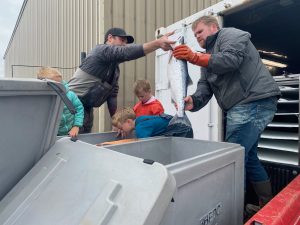Stocks of fish and crab have collapsed in Alaska, devastating both commercial and subsistence fishers
This article is Linda Behnken (alfafishak@gmail.com) of the Alaska Longline Fishermen’s Association, Alaska, US
Climate change used to be something fishers in Alaska talked of as a concern for the future. No longer. That future is now. Alaska has witnessed, almost overnight, collapses in both fish and crab stocks. The cod of the Gulf of Alaska; the Bering Sea king crab and snow crab; and the Yukon River salmon. These collapses have devastated fishers—both commercial and subsistence.
Commercial fish and shellfish condition, survival, population biomass and catch have been negatively impacted by extreme events. They include the marine heat waves of 2014-2016 and 2018-2019 in the Gulf of Alaska and Bering Sea, and the record low ice cover in the Bering Sea. Alaska fishers and coastal communities that depend on vulnerable commercial fish species such Pacific cod, salmon and crab have experienced significant economic losses that are ongoing. Negatively impacted species support high-revenue fisheries and a large proportion of Alaska fishers’ earnings, as also the US fishery harvest value.
Pacific cod are highly vulnerable to ocean warming. The cod population in Gulf of Alaska declined by over two-thirds during the heat wave. The fishery accounts for nearly a third of Gulf of Alaska groundfish value and supports the largest groundfish fleet, mostly smaller fixed-gear vessels owned by Alaska residents. The fishery was a declared disaster in 2018 and again in 2020. Harvests declined by 80 per cent from 2015 to 2019 and fishers’ earning dropped from US $50 million to US $15.5 million. The fleet shrunk in half: from 386 vessels to 176.
The Bering Sea snow crab and Bristol Bay red king crab fisheries are among the most valuable fisheries in the US. The high value and volume of red king crab and snow crab sustain roughly 100 vessels, 500 crew members, 12 processing plants and 2,500 workers. Surveys in 2021 identified record low abundances of snow crab, suggesting a mass mortality event. The total snow crab biomass declined 86 per cent relative to 2018. The Bristol Bay mature red male king crab biomass has declined by over two-thirds, closing the fishery for the 2021-22 season. The economic losses are likely to exceed several hundred million dollars to fishers and processors. The losses to crab-dependent communities such as St Paul in the Pribilof Islands reverberate even farther; the one processing plant on this remote island cannot afford to operate without crab. This leaves the local people without a place to sell their halibut or cod.

Alaska’s most important commercial fish species is salmon, accounting for over a third of Alaska’s fishery value. Ten commercial salmon fisheries from Norton Sound to Southeast Alaska suffered disastrous returns in recent years, affecting fishers and fishworkers throughout the state. Western Alaska fishers have lost access to commercial chinook salmon fisheries, making chum salmon the most important commercial salmon species in the region. Poor conditions in the marine environment have caused ongoing and unprecedented chum run failures throughout western Alaska. The impacts are as dramatic as larger economic losses in other fisheries because of the importance of the cash income to western Alaska rural communities.
On the Yukon River, families that have depended on salmon since time immemorial can no longer harvest fish; it amounts to a loss of sustenance, culture and inter-generational connections. Historically, young people have learned fishing and fish-processing techniques from parents and grandparents, with summer work conducted at fish camps, accompanied by a sharing of cultural knowledge about tides, weather, respect for salmon, and deep connections to place. All that has now stopped—nets and fish camps are empty.
Increased risks
Climate change is identified as the driving force behind crab and salmon run failures. Many also recognize the environmental injustice of ongoing bycatch and habitat impacts associated with the factory trawl fisheries when target and indigenous fisheries are closed. Equity is poorly served by a system that allows high-impact distant-water fleets to preclude small-scale, local people from feeding their families or passing along cultural knowledge to the next generation.
The greying or ageing of the fleet is a well-documented challenge in US fisheries. Alaska is no exception. A number of organizations in the state have worked for years to address this trend through programmes to support the next generation of fishers in gaining skills, capital and access to fisheries. The Alaska Longline Fishermen’s Association (ALFA), in particular, has designed programmes to support young fishermen, from a crew apprentice or training programme to a revolving loan programme. These programmes become more important as climate change increases the risks associated with fishing while coastal families become more vulnerable to supply-chain disruptions and food insecurity. Support for young fishermen is essential.
For more
Fishing is Life
https://www.icsf.net/wp-content/uploads/2021/06/4294_art_Sam76_e_art07.pdf
From the Heart
https://www.icsf.net/wp-content/uploads/2021/06/3804_art_Sam63_E_art11.pdf
Alaska Longline Fishermen’s Association (ALFA)
https://www.alfafish.org/
Alaska’s 2023 ecosystem status reports released by NOAA Fisheries
https://www.nationalfisherman.com/alaska-s-2023-ecosystem-status-reports-released-by-noaa-fisheries